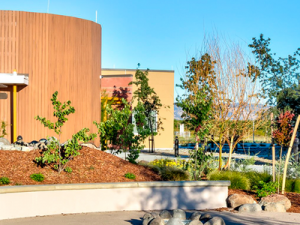Recognizing and addressing vulnerabilities
In 2005, Partners HealthCare purchased a contaminated brownfield parcel of land in the Charlestown Navy Yard for construction to replace the existing Spaulding Rehabilitation Facility. The site is located on a promontory where the Little Mystic Channel meets Boston Harbor, essentially right at the current sea level.
In 2005, when Hurricane Katrina devastated health care infrastructure in Texas, Partners recognized their potential vulnerability, and developed a set of voluntary best-practice requirements for the new facility. When it opened in 2013, the facility became the first building on the Boston waterfront designed for resilience to projected sea level rise.
Building strategically
One of the key decisions Partners HealthCare made to promote resilience against flooding was to place the first floor elevation 30 inches above the FEMA 500-year flood elevation. This is the elevation that flood waters would reach during a flood so extreme it has only a .2 percent chance of occurring each year.
This elevation was much higher than required by code, and Partners also ensured that, despite the elevation, there would be universal access for rehabilitation patients. Designers also placed all critical infrastructure and patient care functions above the first floor. In fact, even if the entire first floor of the building floods, the upper floors can remain fully occupied and operational. All mechanical and electrical infrastructure (incoming electrical service switchgear and panels, as well as emergency generators) is located on the roof, minimizing the chance that a flood will disrupt service.
The building also features a gas-fired, on-site combined heat and power (CHP) system. This system provides energy-efficiency benefits as well as redundancy for power generation in the event that the grid loses power or the diesel generator experiences problems. CHP infrastructure is also on the roof, as are emergency diesel generators.
The building has extensive granite and landscape berms that can absorb and deflect incoming waves from Boston Harbor and the Little Mystic River. The building’s extensive drainage network also allows floodwaters to dissipate quickly if flooding does occur. The hospital’s extensive green roofs also help to reduce stormwater discharge during heavy rainfalls.
The building's high-performance exterior features triple-glazed windows and sun shades that block heat. These features improve thermal performance and prevent low interior temperatures or freezing if heating capacity is lost in winter, as well as overheating if cooling or ventilation is lost in summer. Patient rooms also have key-operable windows, which can reduce the impact of indoor overheating and allow patients to shelter-in-place if the building’s cooling or ventilation system is inoperable. This feature enables the facility to avoid the situation that occured in New Orleans hospitals after Katrina—in some cases, indoor temperatures in sealed New Orleans hospitals exceeded 100 degrees, prompting staff to break windows with furniture to provide ventilation.
Additional benefits in the near term
The measures Partners HealthCare took to improve its resilience against future flooding collectively added between 0.3 and 0.5 percent to the initial cost of construction. These changes were not mandated by federal, state, or local codes. In fact, Partners had to overcome substantial resistance from utilities that were reluctant to place major electrical switchgear above the ground floor.
Nevertheless, in addition to enhancing resilience to likely future flooding, the building’s envelope and energy conservation measures are reducing energy demand in normal operation, thereby reducing carbon emissions. The building uses an estimated 30 percent less energy than a conventional building of comparable size. The ongoing operational savings from these envelope and system measures more than offset the initial additional capital investment.


